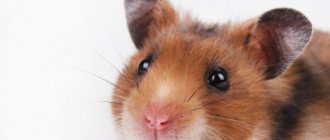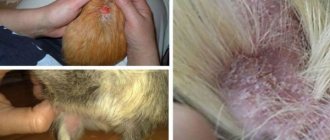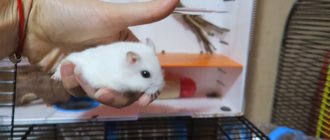If your hamster has fleas, you need to act very carefully. The health of a rodent depends on the correctness of its actions and the chosen treatment methods. Neglect can result in the death of a pet or unpleasant consequences for a person.
To paraphrase a well-known saying, we can say that the person who tamed the animal is responsible for its future fate. Firstly, a small hamster is not a funny “toy”, but a living creature with its own “problems”. The animal may become sick and become infected with parasites. The owner will have to save the animal.
Can a hamster have fleas?
When asked whether hamsters have fleas, you need to look for the answer before the animal enters the house. The decision to have a pet should be a conscious one, so you should initially become familiar with the peculiarities of keeping animals in the house and possible diseases of the rodent. Yes, hamsters have fleas!
The animal's body is covered with fur, and the skin is easily bitten by parasites. Contrary to popular belief, fleas do not live directly on the body of animals, but regularly feed there. For parasites, it does not matter whose blood they drink: a cat, a dog, a mouse or a hamster.
Fluffy Syrian, Royal and Angora hamsters are most susceptible to pest attacks. Animals of the Dzhungar and Roborov breeds suffer less from this scourge.
What is the danger
The bite itself is very unpleasant and causes itching. The flea does not disdain the blood of either animals or people. The worst thing is that it is not so much the bite itself that is dangerous, but its consequences. Sometimes they bite without pain and without leaving a trace, but often there are sensations that are simply impossible to endure. Not only is the itching terrible, but the bite site is also visible to the naked eye. But that's not the worst. Imagine, before reaching your home, the pest bit several stray dogs or cats, then your pet and then you. It is difficult to predict what diseases you can get after such a bite, and if there are several of them. This can bring even the legendary plague. The virus has not been destroyed and is still walking around the world. Although the chance of contracting plague or typhoid is extremely small, there is another set of diseases that can be easily picked up.
In addition, if you do not destroy these parasites, then over time your life will become unbearable . It will no longer be about pets, but about family members. Because fleas reproduce at an incredible rate. Soon these creatures will live in every corner, which means they will also settle in people, you have to eat something. Based on this information, it is in your interests to get rid of them quickly.
Routes of infection
Fleas on a hamster are not a natural phenomenon. This animal is not their permanent “master”. However, under certain conditions they can tire the animal for a long time.
Main sources of infection:
- Other pets and parasites. Cats, dogs, as well as rats and mice are brought into the house. Infection occurs during mating if one of the participants in the process is a temporary host.
- Stay at the pet store. There are situations when a pet is brought into a home already infected. Symptoms are not visible at first, but appear over time.
- Street grass. Rodents are offered green grass that grows outside as food. Eggs and insects themselves are found in sand, soil and thickets. Therefore, the person himself brings the infection into the house.
The likelihood of infection is low, if there are no other pets in the house, feed the animal with special food and prevent the presence of street rodents.
Preventive measures
In order to prevent the spread of fleas in a private household or apartment, the tenant performs the following actions:
- regularly examines the hamster for the presence of bloodsuckers in its fur;
- uses specific plants that smell strongly (for example, wormwood). Then the household member lays out this grass near the cage. The fragrant smell of wormwood does not affect the hamster in any way, but fleas are afraid of it and quickly run away from there;
- cleans and treats the hamster cage with special insecticidal agents;
- before adding a second rodent of the same type to the hamster, the tenant treats it with an anti-flea drug;
- When walking a hamster outdoors, pre-treat it with anti-flea drops or another insecticide to prevent the rodent from becoming infected with fleas.
Thus, by following the simple recommendations listed above, the hamster owner prevents the occurrence of fleas in such a rodent and thereby protects himself and the animal from unpleasant “surprises”.
Symptoms of flea infestation
The presence of parasites can be recognized by their characteristic signs. Fleas cause discomfort and pain to your hamster. The behavior and appearance of the animal changes. He becomes restless, sleeps poorly, loses his appetite, often itches and chews his fur.
The examination reveals:
- blisters and bite marks on the body;
- encrusted blood stains;
- sand-like grains;
- receding hairline;
- combs.
If the owner leaves the pet without proper attention, infection penetrates into the wounds, inflammation begins, and purulent formations appear.
The first signs of fleas on a hamster's fur
At the moment, the appearance of various types of fleas in a hamster is indicated by specific signs that become noticeable upon closer examination of the rodent.
Thus, when such bloodsuckers settle on this animal, its owner observes the following symptoms:
- the hamster's skin becomes covered with small wounds that arise due to this pet scratching the area of flea bites;
- bald patches appear on the rodent;
- dandruff forms under the hamster's fur - a peculiar reaction of the body to the presence of bloodsuckers;
- the hamster itches intensely and for a long time, and also causes severe pain to itself.
Also, the owner of a hamster determines the presence of fleas on him in this way - he slightly pushes the rodent’s fur apart with his fingers. If very small black parasites are visible underneath, then this is a flea infestation in your pet.
Thus, if the above symptoms occur, you should immediately begin treating your hamster. Moreover, it is better to first visit a veterinarian, who will make an accurate diagnosis and then prescribe the correct, highly effective treatment.
The danger of parasites for hamsters and humans
Severe infection leads to death in a short time. Parasites irritate with their bite, drink blood, exhaust and weaken the animal. In addition, the presence of insects on a pet’s body is dangerous for the development of other serious diseases.
- Fleas are carriers of helminth eggs. At the moment when the rodent tries to remove the leech with its teeth, the worm eggs enter the hamster's body. The first symptoms of infection may appear after 14 days.
- Infection occurs in open wounds and scratches. Dermatitis, eczema, and abscesses appear on the body. In addition, insects spread plague, salmonellosis, and typhus.
- The flea animal loses sleep, appetite and strength. Nervous and physical exhaustion leads to death.
Insects are not that dangerous to humans. Fleas do not specifically attack people; they attack when a room is heavily infested.
What not to do
Do not get your hamster's fur wet. The animal will try to dry itself and dangerous particles from its coat will fall into the esophagus. The result is the development of helminths.
Do not use drops on the withers or anti-flea shampoos for cats and dogs. The products are dangerous for the small body and skin. There is no drop on the withers for rodents.
Do not buy medications yourself after reading reviews or descriptions on the Internet. Products are recommended only by a veterinarian.
Rodent treatment
After you have discovered fleas on your hamster, it is worth asking the pressing question of how the infection occurred. Timely treatment ensures a quick recovery for the pet and a restful sleep for the owner.
What you should not do is bathe your hamster with flea shampoo for cats and dogs. Animals do not tolerate water procedures well and risk dying from a cold. It is recommended to use special products at home or seek help from a veterinarian.
Flea drops
They are considered the most effective and convenient to use. To fully treat the animal, you need to apply 1-3 drops of the product to the withers, where the hamster cannot reach the teeth.
Within 2 hours, the active components are completely absorbed by the skin, localized in the hair follicles and in the upper layer of the epidermis. The poison enters the body of insects through bites.
The effect of the drug lasts from 1 to 3 months. Drops are used to treat and prevent re-infection.
For the treatment of rodents, it is recommended to choose safe agents whose active components do not enter the systemic bloodstream. These include, for example, drops for treating cats.
A product for dogs is also produced under this brand, but the dosage is higher, so it is not suitable in this case. If your hamster has fleas and you don't know what to do, buy a few drops for cats and apply them once.
Injections
This treatment method is suitable when the animal is heavily infected and the likelihood of reinfection is high. The veterinarian knows very well how to remove fleas from a hamster with an injection, so there would be no shame in using his services.
The product used can cause serious side effects, including death, so the rodent should be tested the first time. Typically, ivermectin 1% is used twice at 15-day intervals.
Insecticidal powder
The product in powder form is applied to the animal’s body and gently rubbed into the skin. The active components begin to act immediately. Insecticides paralyze insects on contact, after which they die.
The action lasts about 2 weeks. If necessary, repeat the course of treatment. For the treatment of domestic hamsters, veterinarians prescribe Insectal and Celandine.
Anti-parasite sprays
The drug is produced in finished form in a special aerosol can. To remove fleas from a hamster, it is enough to treat your pet's fur once.
The spray gun should be kept at a distance of 5 cm from the surface to be treated. The product dries quickly, but preferably 20 minutes after treatment, make sure that the pet does not lick the spray from the fur.
It is recommended to use a special Ultra Care spray for rodents, a flea and tick spray for small animals, or a product for cats, such as bars.
How to detect the presence of parasites
Very often, hamster owners notice the appearance of blood-sucking parasites only when the pet’s life becomes completely unbearable. The reason for this is the animal’s excessive activity. Rodents themselves are very clean, and pay enough attention to hygiene, constantly licking and combing their fur coat. Therefore, regular examinations of your pet should be carried out, which will help identify parasites as early as possible. There are several main signs that unmistakably indicate a problem.
Active behavior
When parasites appear, the pet’s usual calm existence is replaced by sleepless nights and inappropriate behavior.
The skin reaction to bites is various forms of itching, which provoke the following characteristic actions:
- restless movement around the cage during the day and night;
- scratching the skin in certain places;
- attempts to bite parasites out of wool.
Skin problems
Very often, the appearance of parasites can go unnoticed for a long time. Frequent scratching leads to inflammation of the skin.
Clear signs of the appearance of fleas and a signal to take urgent action may include:
- bald patches on certain areas of the body;
- the appearance of dandruff, which was not previously observed;
- growths and crusts on the surface of the skin.
Detection of parasites or their feces
In order to detect “uninvited guests”, you should examine the fluffy very carefully. The most favorite places for fleas on a rodent's body are the stomach and the area behind the ears. As soon as you part the fur, you will see insects. If there are fleas on the animal's skin, you can find small red spots that cause irritation and scabies.
Did you know? If a person of average build and height had the same jumping ability as a flea, he could make a high jump of 140 m and 270 m in length.
If the rodent is a carrier of a small number of parasites and the fleas themselves are not visible, then the presence of small black lumps on the hamster’s fur can be considered a sign of their vital activity. This dark “sand” on the animal’s skin is the feces of blood-sucking parasites. Insect nests can also be observed.
Cell processing
Adult insects jump onto the animal's body for the purpose of feeding; they are rarely found there all the time. The eggs are scattered throughout the house, and the larvae often develop in the litter tray, the hamster's cage. To destroy parasites, it is necessary to clean the “house” and disinfest the cage.
Remove food debris, clean bowls, drinking bowls. Toys are washed with soap. The bed is washed and then steamed. The cage is treated with an insecticidal spray. Any product will do, including Dichlorvos. They do this in the fresh air and after 3 hours you can throw the animal there.
How to get them out
You can get rid of fleas on your hamster using any insecticide available at the pet store. Among them there are products specifically designed for hamsters - their concentration will not harm the baby, but will destroy fleas.
Among the most popular means are the following:
- Insecticidal powder;
- Spray against fleas and other insects;
- Drops on the withers (may contain both insecticidal and acaricidal substances that kill the more common hamster parasites - mites).
Good to know! Brands such as Frontline and Stronghold produce special long-acting therapeutic and prophylactic preparations for rodents, intended for application along the spine.
Shampoos are not used for hamsters, as they cannot be wetted. Recently, treats for hamsters have appeared that contain anti-flea agents, but not all of them are equally willing to eat them.
Hamster and pills
Important! If you are not sure you know how to treat your hamster, consult your veterinarian.
When starting to remove fleas, you need to take into account that their eggs and larvae do not live on their hosts. For many millennia, the flea has chosen burrowing animals for its life, since its eggs are unable to stay on the fur of animals; they are dropped onto the litter in a burrow or nest, where larvae emerge from them and feed on dead organic matter (scales of skin, dirt, sweat and excrement of adult insects ). Having moulted, they turn into adults and only then begin to hunt animals for blood.
So, to be sure that we got rid of fleas, we need to change the bedding in the cage to fresh one, and wash the cage itself with hot water and washing powder or laundry soap.
Treating all pets and your home for fleas
Since the rodent cage is indoors and flea eggs may be scattered everywhere, it is recommended that all pets be washed and treated.
In case of severe infection, it is recommended to disinfest the premises; in other cases, folk remedies are used.
- Sprinkle carpets with boric acid powder and vacuum every other day.
- Wash floors with water and vinegar or ammonia. For 1 liter of water, one tablespoon of product.
- Clean the walls with a solution at a height of 1 m above the floor level.
- Pour boric acid into the cracks.
Be sure to treat the room, otherwise you will have to constantly fight pests.
Prevention measures
To destroy all individuals and prevent their reappearance, you should consider the following recommendations and tips:
- 90% of the entire population lives outside the hamster's cage. It is important to carefully inspect your pet's fur, bedding and other items. Having seen at least one individual, you should immediately treat the animal and its home;
- eggs and larvae are located throughout the house. Regular wet and dry cleaning will help remove adults and their offspring;
- the vacuum cleaner is washed thoroughly, and the dirt from the bag or plastic container is thrown directly into a street trash container;
- pay special attention to upholstered furniture on which a cat or dog sleeps. Apply insecticides in the form of carpet powders and sprays. The best means are Raptor, Combat and Raid;
- Regularly inspect the fur of other pets. If your cat likes to spend time outside, you should buy a flea collar. This way, the pet will not bring dangerous parasites into the house;
- You can put strong-smelling plants or fruits near the cage. They will not harm the hamster, but the flea will get “a lot of pleasure.”
Close floor gaps in a private home. In the basement you can arrange twigs of wormwood and bouquets of Dalmatian chamomile. The specific smell of these plants repels insects. An effective procedure would be general cleaning, with washing of all things. Fleas prefer to live in closets, chests of drawers, televisions, and so on.
Be sure to contact your veterinarian
Features of using powder
The most convenient form of antiparasitic release that is suitable for rodents. The powder is easy to apply by dusting:
- Open the container with powder.
- Using a small cotton swab, apply the powder evenly over the entire surface of the body, avoiding getting the product into the eyes and mouth of the rodent.
- Repeat the procedure after 14 days. This will help avoid re-infection.
- After treating the animal, you need to disinfect the cage and other animals, if any, with this product.
Hamsters generally do not like strong sounds and smells, so sprays are the least popular form of antiparasitic for rodents.
If there is no other product at hand and you need to treat the hamster with an aerosol, you should spray the liquid carefully and evenly, avoiding contact with mucous membranes and the mouth.
The drug contained in disposable pipettes must be applied to the rodent using a point method. Depending on the size of the hamster, you need to apply from 3 to 5 points. Drops are applied to areas of the body that are difficult to lick.
Important. After treating the hamster, it is imperative to disinfect the cage and the entire apartment. Paying special attention to carpets, furniture, bedspreads and towels.
Gastrointestinal diseases
There are various diseases of hamsters that are caused by pathogenic microorganisms. Among them, veterinarians identify pathologies of the digestive tract. They cause gastrointestinal disorders, and in severe cases can lead to the death of the animal.
Worms are also common in hamsters, which enter the body along with contaminated food or water. The disease can be determined by the slow growth of young animals, sudden weight loss (with normal nutrition), problems with fur (for example, oily sheen)
It is also worth paying attention to the consistency of the stool: it becomes soft, the mass contains blood, mucus or fragments of parasites
Colibacillosis
This disease in hamsters is caused by E. coli. Colibacillosis is also called “wet tail”. This is because loose stools cause the fur around the hamster's anus to be wet.
The disease occurs as a result of the penetration of E. coli into the body. The source of infection is contaminated food or water.
You can tell that your hamster has colibacillosis by the following symptoms:
- watery diarrhea with a pungent odor;
- decrease or disappearance of appetite;
- weight loss;
- anxiety;
- depression, lethargy, apathetic state;
- exhaustion of the body;
- sometimes high temperature;
- uncertain movements;
- increased heart rate and breathing.
Specific signs of colibacellosis are loose stools and wet fur around the anus. The hamster is constantly trying to find a secluded place and curl up into a ball. He looks sloppy, his fur is disheveled, his ears are flattened, he doesn't move much.
The disease develops quickly, so treatment must be started in the early stages. Therapy is carried out under the supervision of the attending physician. The infection should be treated with electrolyte solutions and antibiotics (tetracyclines are often used). The former improve the hydration process, while the latter destroy bacteria in the intestines.
Therapy is carried out at home. During the treatment period, you must follow the diet prescribed by the ratologist.
Escherichia coli
Hamster diseases caused by E. coli can lead to the death of the pet. The infection begins to develop after a pathogenic microorganism enters the animal’s body, which begins to multiply rapidly. Because of this, the natural intestinal microflora changes, and the hamster’s condition deteriorates sharply.
Signs of an illness caused by E. coli:
- high body temperature;
- diarrhea with blood streaks;
- weakness, apathy;
- the animal does not eat anything;
- weight loss;
- blanching of the mucous membranes.
The infection progresses quickly and often ends in the death of the animal. To prevent this from happening, when the first symptoms of the disease appear, you need to contact a ratologist. The doctor will prescribe a bacteriological analysis to identify the pathogen and develop treatment tactics. Intestinal antiseptics and antibiotics will help destroy the source of infection.
You can get E. coli from a sick hamster. To avoid this, a person should thoroughly wash their hands with soap after contact with the animal. To prevent illness, you should keep your home clean.
Enteritis
This is a disease in which the inflammatory process affects the small intestine (some parts or all of it). As a result, its functionality is impaired, and dystrophic changes appear on the mucous membrane. Then various digestive disorders arise.
The main reason for the development of enteritis in a hamster is considered to be the lack of hay in its diet. The disease is manifested by increased gas formation in the intestines and diarrhea.
Enteritis is treated by introducing high quality hay into the hamster's diet. Specific therapy is also carried out: the feces of a healthy animal are diluted with water, and then administered through an enema into the patient’s intestines.
Precautionary measures
A week after the initial treatment, you will need to undergo another course of treatment. Repeating the procedure will prevent another flea infestation.
The cell is disinfected with a solution of metrifonate and bromocyclene. The rodent should not be allowed into the cage immediately after it has been treated. Move your pet to another place for two weeks, thoroughly ventilate its home and wait until it dries.
Also, do a thorough cleaning of the entire apartment. You can also treat the rooms in the apartment with a special spray.
Why are fleas dangerous?
Aphanipterosis is not fatal to rodents, but there are indirect threats:
Worms
By biting insects made from wool, the animal can become infected with helminths. Therefore, after getting rid of fleas, it is recommended to give the animal an anthelmintic (Shustrik suspension).
Infection
Fleas are still carriers of dangerous diseases: plague, typhoid, salmonellosis. With advanced skin problems, the usual non-exotic microflora is layered and abscesses occur in the rodent.
Stress
The flea hamster cannot eat or sleep peacefully, loses weight, and becomes nervous and aggressive.
general description
If we talk about parasites such as fleas, it should be said that there are a huge number of varieties. For example, cats, dogs, mice and many others. But the fact is that they all have a fairly good appetite and, in search of food, do not go overboard when choosing a victim. So, a hungry dog flea can bite absolutely all warm-blooded animals.
Regarding the most common parasites, these include the cat flea. She can also attack hamsters, but only to satisfy her hunger. They do not take root on little furry friends, so after satisfying their hunger, they most often leave it. But parasites such as rats and mice pose a very great danger to animals.
What additional treatment measures
The house should be thoroughly cleaned. Carpets are dried. Clean the floors thoroughly. All corners and areas where animals are located are treated with special chemicals. This is necessary to destroy parasites throughout the house.
No animals should be present in the room during processing. Pets are taken out for a while.
Please note that all pets need to be treated at once. This is done even if fleas were found on only one of the pets. If this is not done, the parasites will appear again after a short period of time.
It is important to carry out a complete treatment of the room










